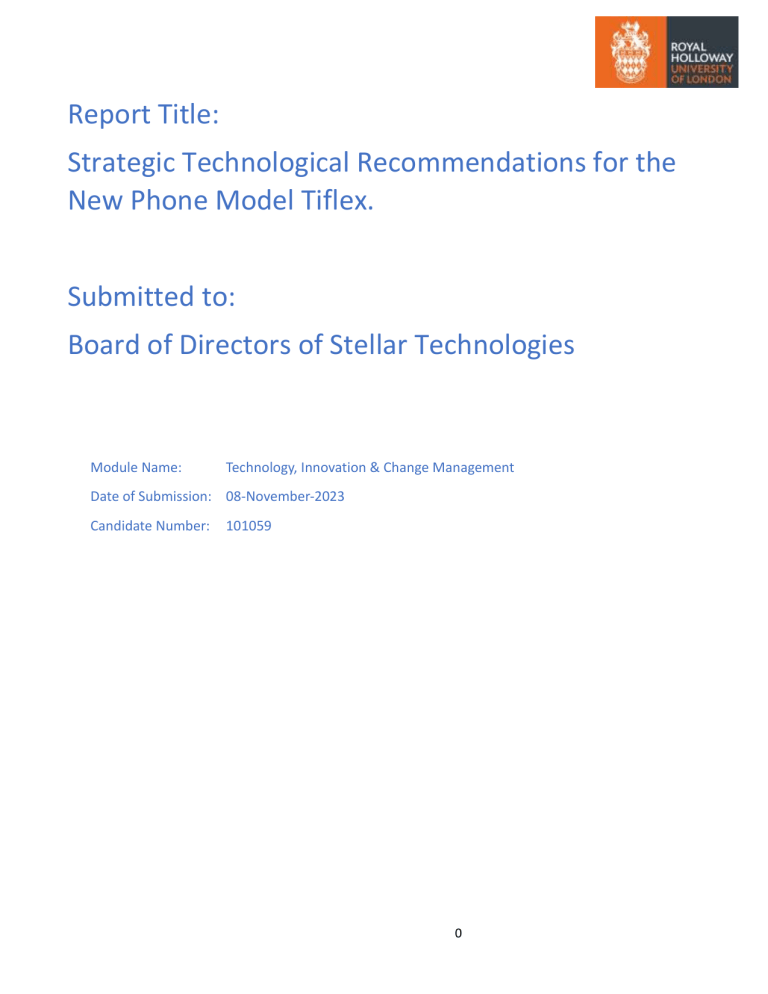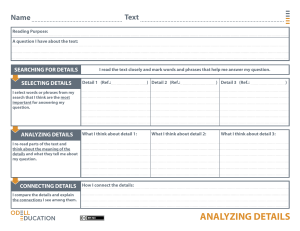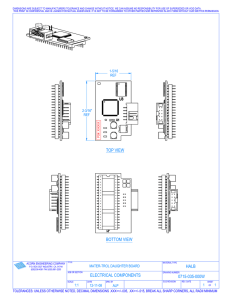
Report Title: Strategic Technological Recommendations for the New Phone Model Tiflex. Submitted to: Board of Directors of Stellar Technologies Module Name: Technology, Innovation & Change Management Date of Submission: 08-November-2023 Candidate Number: 101059 0 Table of Contents Chapter 1: Choosing a Market Segment ....................................................................................................... 2 2.1 who: .................................................................................................................................................... 2 2.2 what: ................................................................................................................................................... 2 2.3 How: .................................................................................................................................................... 3 Chapter 2: Bases of Competition & Key Success Factors .............................................................................. 4 2.1 Bases of competition:.......................................................................................................................... 4 2.2 The Key Success Factors (KSFs)............................................................................................................ 4 Chapter 3: Technologies to be used to support KSF. ..................................................................................... 5 Chapter 4: Competitive strengths and weaknesses of in key technologies .................................................. 7 Chapter 5: Technology Objective as targeted in CI/CP and timeframe to achieve target position:.............. 9 Chapter 6: Sourcing Recommendations...................................................................................................... 10 References ................................................................................................................................................... 12 1 Chapter 1: Choosing a Market Segment Markides, C. C. (2000) suggested that the goal for every company should be to answer the following 3 questions Who will be our target customers? What will we offer them? How will we do it? In this document, we will answer these questions for devising a successful strategy. 2.1 who: The market is broadly divided in 5 segments (details provided in Annexre-1), in our technology strategy, we recommend that our target segment should primarily be "achievers." The achievers can be broadly categorized as an egocentric group, and it makes strategic sense to focus on this segment of consumers in the mobile market based on our business and technology strategy. Achievers are characterized by their strong emphasis on their success, power, aspiration, status, and visibility. Importantly, this group attributes a higher value to factors other than price, allocating 60% of their importance to elements. Such as they value satisfying their ego, and for them a mobile phone is more of proof of success and modernism. They are satisfied with their positioning within their social class, impressing colleagues, and do not demand very high-quality products. This segment of the market falls among the early adopters who act as a catalyst for market penetration by accepting and adopting innovation leading to increased market share. 2.2 what: The phone design and main features will include the titanium body with rollable/flexible display (flexible screen idea from Moto Rizr rollable Concept Phone). Titanium phones are more durable and solid due to its nature of exceptional strength-to-weight ratio. The Grade 5 (aka aerospace grade) titanium is more shock resistant and contributes to a sleek and premium design. The phone design will draw inspiration from one of the iconic Nokia 8800 Sirocco from 2006, a modern titanium phone with a flexible display will provide a blend of elegance with modern technology. The sliding mechanism will be utilized to roll out the display, offering an expanded screen size that significantly enhances the user's visual experience. The phone will be offered in different sizes by adopting product proliferation strategy with different prices according to size and specs to attract a broad range of customers. 2 We will also be introducing a new and unique feature i.e. customizable fragrance. This feature is designed with our customers' preferences in mind, and it can be easily turned off for those who may not wish to use it. We believe this feature will not only be unique but it will also add a unique sense of personalization to the customers by choosing from a range of available fragrance cartridges. Our fragrance cartridges will be distinctively designed, by collaborating with renowned designers to offer cartridges inspired by their famous perfumes. 2.3 How: Our goal is to provide innovative devices with the highest quality standards in reduced price by making our processes efficient (process innovation) and improving the supply chain (Business innovation). The quality standards will be ensured by rigorous physical testing before the launch of the product. These tests will evaluate the strength of our devices in real-world usage. This will also include drops and impacts tests and exposure to different environmental factors tests. This detailed quality control process guarantees that our mobile phones are not just technologically advanced but also built to withstand the demands of daily life, providing users with reliable and durable devices. We are also recommending extending the warranty period to 1.5 years from 1 year, the extended warranty will be an added advantage to our customers to get attracted to our product in comparison to our competitors, who are offering lower warranty period. We are also discussing with different insurance companies for offering theft and accident insurance cover to all the mobile phones we are selling in market and if we get a good quote, we will add some portion of the insurance cost in the price, and some will be paid form the profit margins. Price will be kept at a minimum by reducing process costs by applying better technology Floyd (1997) chapter 1, mainly by effective technology management techniques. 3 Chapter 2: Bases of Competition & Key Success Factors The basis of competition reflects the purchasing criteria the customers use in making purchase (Floyd-1997), in other words the core attributes and qualities which will influence the customer for purchase of our product over those of our competitors. 2.1 Bases of competition: Floyd (1997, sourced Arthur D Little) in chapter 3, defined principally 9 bases of competition, out of those 9. Details of these 9 BOCs are provided in Annexure-2. However as per our internal study of market analysis (purchasing criteria) Annexed at Annexure-3, achievers give 40% value to the price and 60% to other factors. We will focus on three bases of competition that I suggest to the board as I find these the most important to our target segment are price, image (design of phone) and satisfaction (including quality, and after-sales services). 2.2 The Key Success Factors (KSFs) KSFs related to mechanical & physical aspects of these BOCs are provided in below table along with their relevance to each of the BOCs. BOC-1 Price KSF-1 Choosing a cost-effective option for technology acquisition to keep competitive pricing. KSF-2 Low cost of production process and improved supply chain BOC-2 Design KSF-1 Modern technology of rollable display. BOC-3 Quality KSF-1 Rigorous Quality checks through Third party Testing Company. KSF-2 Stylish Metal design with Sliding mechanism. KSF-2 Provision of extended warranty and insurance. 4 Chapter 3: Technologies to be used to support KSF. Key Success Factors for which each Technology is relevant Technology Ref # Surface appearance using Titanium. Ref # 1133 Electrical stimulation of surface materials. Ref # 132 KSF 1: Choosing a costeffective option for technology acquisition to keep competitiv e pricing. KSF 3: KSF 2: Low Stylish cost of Metal productio design n process with and Sliding & improved perfume supply mechanis chain. m Surface coating method. Plating Ref # 125 Optimise static/dynamic mechanical behaviour using physical testing. Ref # 322 Surface characteristics, Smell Ref # 26 KSF 4: Modern technology of rollable display. KSF 5: Aestheti cally pleasing design + good built quality & compon ents KSF 6: Provision of after-sales services with extended warranty and insurance 5 Thin wall moulding design Ref # 332 The technologies which are suggested to be adopted for the achievement of our business goal is by providing a titanium body (technology Ref # 1133) with a rollable display through the Technology of electrical stimulation of surface materials Ref # 132. We will be producing this design through Thin-wall moulding design technology (Ref # 332) which will help in the creation of lightweight, sleek, and compact mobile phones while maintaining the structural integrity required to withstand daily use and potential accidents. Furthermore, we will opt for surface coating plating technology (Ref # 125), which will impart an additional layer of sophistication and niche appeal to its appearance and will also make it scratch, shock and erosion resistant. We will also be introducing a new and unique feature i.e., customizable fragrance by using the surface technology characteristic of smell (Ref # 26). The quality standards will be ensured by rigorous physical testing before the launch of the product by optimising static/dynamic mechanical behaviour using physical testing technology (Ref # 322). These tests will evaluate the strength of our devices in real-world usage. This will also include drops and impacts tests and exposure to different environmental factors tests. This detailed quality control process guarantees that our mobile phones are not just technologically advanced but also built to withstand the demands of daily life, providing users with reliable and durable devices. 6 Chapter 4: Competitive strengths and weaknesses of in key technologies Floyd (1997) described once we have the key technologies for our product's success, we may determine our competitive position in relation to the competitive impact of each of the key technology to devise the technology acquisition strategy. The following table represents our CI/CP analysis. Technology We know how to We know how to design surface appearance using Titanium. Ref # 1133 We know how to design Electrical stimulation of surface materials. Ref # 132 We know how to design Surface coating method. Plating Ref # 125 Competitive Impact (CI) Competitive Position (CP) Clear Leader Strong Favourable Tenable Base Key Pacing Emerging Base Key Pacing Emerging Base Key Pacing Emerging We know how to design Optimise static/dynamic mechanical behaviour using physical testing. Ref # 322 We know how to design control surface characteristics, Smell Ref # 26 We know how to design Thin wall moulding design Ref # 332 Base Key Pacing Emerging Base Key Pacing Emerging Base Key Pacing Emerging 7 Weak Our current competitive position in key technology titanium (Ref # 1133) is strong but in the pacing technology for rollable display, illumination using Electrical stimulation of surface materials Ref # 132), we are lagging and currently at a tenable stage. These are alarm signals for the future of the company. We are at best competitive position at the key technology surface coating plating Ref # 125, where we are clear leader. We are also at a strong position at the pacing technology of Controlling surface characteristics, in particular, smell (Ref # 26) and favourable at key technology of Thin-wall moulding design technology (Ref # 332). The most worrisome competitive position is of technology optimising static/dynamic mechanical behaviour using physical testing (Ref # 322), which is a base technology and we are at the tenable position. We should be taking quick measures to improve our positions in this base technology, otherwise, it may be difficult for us to survive in the industry. 8 Chapter 5: Technology Objective as targeted in CI/CP and timeframe to achieve target position: My technology objective recommendations for each of the six technologies are provided in detail in the below table. These recommendations are open for discussion for further improvements. Technology we know how to….. Or Ref # Strategic objectives for capability development what to do (build capacity, sustain, cut back) Why We know how to design surface appearance using Titanium. Ref # 1133 Sustain Opportunity to make maximum profit in current time as strong at key technology mean opportunities now for competitive advantage. We know how to design illumination using Technology, electrical stimulation of surface materials Ref # 132 Build-capacity Tenable at pacing technology means alarm signals for the future. We know how to select/evaluate/design using, as the surface coating method, Plating coating Ref # 125 Sustain. Opportunity to make maximum profit in current time as clear leader at key technology mean opportunities now for competitive advantage. We know how to optimise static/dynamic mechanical behaviour Using physical testing. Ref # 322 Build-capacity Target CP: Favourable CI: Base 3 months. Our competitive position at a base technology is tenable. This means alarm signals for survival. We should work on emergency bases to improve in this technology for ensuring product quality, durability and customer satisfaction and hence improving brand's reputation. We know how to control surface characteristics, in particular, Smell. Ref # 26 Build-capacity Target CP = Strong CI = Key Strong at pacing technology mean opportunity for future. So, we need to improve in this field to make it a key technology and take the competitive Target CP: Favourable CI: Key 9 months. 9 We know how to make trade-offs between strength and weight through thin wall moulding design. Ref # 332 Duration 9 Months. advantage in future. Sustain Our current CP is this key technology is favourable, so we would sustain this position and use the resources to acquire the technologies in which we are weak and tenable. Chapter 6: Sourcing Recommendations Sourcing recommendations for the acquisition of these technologies are provided below table. These recommendations are open for discussion and will be revised accordingly. Add partner details (University, Supplier, competitor) Technology we know how to….. Or Ref # We know how to design surface appearance using Titanium. Ref # 1133 Strategic Objectives for Technology Sourcing where to Source Why Make internal R&D Strong at key technology offers genuine source of Competitive advantage. We know how to design illumination using Technology, electrical stimulation of surface materials Ref # 132 Collaborate with supplier (LED/OLED screens supplier) Our current position is tenable at pacing technology. So, to reduce costs, risks and time and to catch-up from a weak position quickly collaboration is a better option. We know how to select/evaluate/design using, as the surface coating method, Plating coating Ref # 125 Make internal R&D Currently, we are clear leader at key technology which offers a genuine source of Competitive advantage. We know how to optimise static/dynamic mechanical behaviour Using physical testing. Ref # 322 Buy (outsourcing the testing services) Technology does not offer a competitive advantage. Access to specialised skills and services in non-core area. 10 Outsourcing will reduce risks, costs and time. We know how to control surface characteristics, in particular, Smell. Ref # 26. Make internal R&D Technology may be developed internally. But Collaborate with Designers for fragrances/perfumes cartridges. Strong at pacing technology offers genuine source of competitive advantage in future. So, the technology will be developed internally but for the fragrances, we would have to collaborate with perfume designers. We know how to make trade-offs between strength and weight through thin wall moulding design Ref# 332 Make internal R&D We would sustain the Favourable, CP and use the resources on other technologies in which we are weak and tenable. 11 References 1. https://www.strategybusiness.com/article/05406#:~:text=Lavish%20R%26D%20budgets%20don't,basics%20of%20a% 20better%20strategy.&text=The%20quest%20for%20innovation%20has,more%2C%20and%20pr ofit%20will%20come. 2. https://www.adlittle.com/en/press-release/arthur-d-little-top-global-innovators-identified 3. Reference from Tidd & Bessant (2020) 4 P model of Innovation 4. The 4Ps Innovation Space Model | Product |Process | Position |Paradigm Innovation (biznewske.com) 5. Dechamps & Nayak (1995) 6. 1993_Q2.PDF (adlittle.com) 7. Motorolla Rizr Concept phone with extendable display (youtube video) 8. Markides (2000) (slide5/53) of lecture 2 All the Right Moves - HBS Working Knowledge - Harvard Business School 9. Floyd Managing technology for corporate success | Emerald Insight 10. What is your basis of competition? Or what can you safely outsource? - Horses for Sources | No Boundaries 12 13




